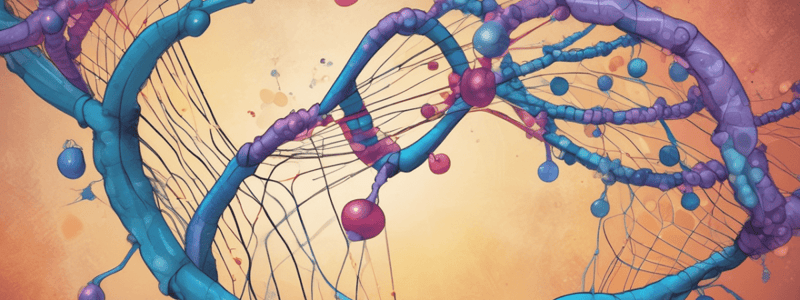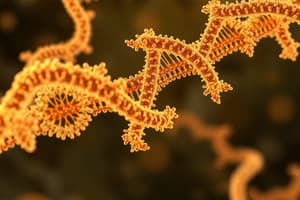Podcast
Questions and Answers
What is the primary advantage of using cDNA instead of genomic DNA for cloning?
What is the primary advantage of using cDNA instead of genomic DNA for cloning?
- It increases the complexity of the DNA sequence
- It produces a smaller clone size (correct)
- It allows for the expression of non-coding regions
- It eliminates the need for reverse transcription
What is the main purpose of creating a cDNA library?
What is the main purpose of creating a cDNA library?
- To represent the genes being expressed in a cell population (correct)
- To study the regulation of gene expression
- To analyze the structure of genomic DNA
- To identify genes that are not expressed in a particular cell type
What is the primary function of reverse transcriptase in cDNA synthesis?
What is the primary function of reverse transcriptase in cDNA synthesis?
- To amplify DNA sequences
- To translate mRNA into protein
- To remove introns from genomic DNA
- To convert mRNA into DNA (correct)
Why is it necessary to harvest mRNA from different cells?
Why is it necessary to harvest mRNA from different cells?
What is the benefit of using DNA sequencing to characterize genes?
What is the benefit of using DNA sequencing to characterize genes?
What is the primary application of DNA cloning in biotechnology?
What is the primary application of DNA cloning in biotechnology?
What is the primary purpose of using ddNTPs in automated DNA sequencing?
What is the primary purpose of using ddNTPs in automated DNA sequencing?
How do automated DNA sequencers distinguish between different ddNTPs?
How do automated DNA sequencers distinguish between different ddNTPs?
What is the primary advantage of Next Generation Sequencing (NGS) over previous sequencing technologies?
What is the primary advantage of Next Generation Sequencing (NGS) over previous sequencing technologies?
What is the estimated number of protein-coding genes in the human genome?
What is the estimated number of protein-coding genes in the human genome?
What is the primary purpose of separating DNA fragments on a capillary gel?
What is the primary purpose of separating DNA fragments on a capillary gel?
What is the average read length of fluorescent capillary dideoxy sequencing?
What is the average read length of fluorescent capillary dideoxy sequencing?
What is the primary difference between the original radioactive dideoxy sequencing and fluorescent capillary dideoxy sequencing?
What is the primary difference between the original radioactive dideoxy sequencing and fluorescent capillary dideoxy sequencing?
What is the advantage of Next Generation Sequencing (NGS) over fluorescent capillary dideoxy sequencing?
What is the advantage of Next Generation Sequencing (NGS) over fluorescent capillary dideoxy sequencing?
What is the primary purpose of DNA sequencing?
What is the primary purpose of DNA sequencing?
What is the role of dideoxynucleotides in DNA sequencing?
What is the role of dideoxynucleotides in DNA sequencing?
What is the difference between deoxynucleotides and dideoxynucleotides?
What is the difference between deoxynucleotides and dideoxynucleotides?
What is the result of incorporating a dideoxynucleotide into a DNA strand?
What is the result of incorporating a dideoxynucleotide into a DNA strand?
What is the purpose of using dideoxynucleotides in the Sanger sequencing method?
What is the purpose of using dideoxynucleotides in the Sanger sequencing method?
What is the result of using a mixture of dCTP and ddCTP in DNA sequencing?
What is the result of using a mixture of dCTP and ddCTP in DNA sequencing?
Why is the Sanger sequencing method also known as the dideoxynucleotide chain-termination sequencing method?
Why is the Sanger sequencing method also known as the dideoxynucleotide chain-termination sequencing method?
What is the advantage of the Sanger sequencing method?
What is the advantage of the Sanger sequencing method?
What is the primary purpose of reducing the reaction temperature to 45-68°C during the PCR process?
What is the primary purpose of reducing the reaction temperature to 45-68°C during the PCR process?
What is the temperature range for primer extension during the PCR process?
What is the temperature range for primer extension during the PCR process?
What is the purpose of repeating the PCR cycle 30 times?
What is the purpose of repeating the PCR cycle 30 times?
What is the primary application of PCR in genetic diagnosis?
What is the primary application of PCR in genetic diagnosis?
What is the purpose of using PCR in forensic analysis?
What is the purpose of using PCR in forensic analysis?
What is the primary function of DNA microarrays?
What is the primary function of DNA microarrays?
What is the temperature used for denaturation during the PCR process?
What is the temperature used for denaturation during the PCR process?
What is the purpose of gel electrophoresis in PCR?
What is the purpose of gel electrophoresis in PCR?
What is the primary function of nucleic acid hybridisation in the context of DNA microarray?
What is the primary function of nucleic acid hybridisation in the context of DNA microarray?
What is the purpose of converting mRNA into cDNA in the DNA microarray method?
What is the purpose of converting mRNA into cDNA in the DNA microarray method?
What is the role of the chip reader in the DNA microarray method?
What is the role of the chip reader in the DNA microarray method?
What is the outcome of the hybridization process in the DNA microarray method?
What is the outcome of the hybridization process in the DNA microarray method?
What is the purpose of creating an array of single-stranded DNA on the microarray slide?
What is the purpose of creating an array of single-stranded DNA on the microarray slide?
What is the relationship between the brightness of the fluorescent spots on the microarray and the level of gene expression?
What is the relationship between the brightness of the fluorescent spots on the microarray and the level of gene expression?
Flashcards are hidden until you start studying
Study Notes
Reverse Transcription and cDNA
- mRNA is produced when genes are transcribed, but it does not contain introns
- To express eukaryotic proteins or identify genes expressed in a particular cell type, we need to make DNA copies of the transcribed mRNA
- Complementary DNA (cDNA) is a DNA copy of a mRNA, produced using an enzyme called reverse transcriptase
- cDNA libraries contain complementary DNA copies of the mRNAs present in a cell population and represent the genes being expressed in the population from where the mRNA is harvested
- cDNAs are used as the introns are removed and the clone size is smaller
DNA Sequencing
- Full characterisation of genes within the genome can be obtained by sequencing our DNA
- This provides the sequence of bases which can be used to predict the sequence of amino acids contained in the protein that the gene encodes
- DNA sequence from different individuals can also allow us to discover genetic differences, the first step to personalized medicine
- DNA sequencing method devised by Sanger is the most common method (Nobel Prize 1980)
- Uses DNA polymerase to copy single-stranded DNA
- Makes use of ‘dideoxy’ nucleotides which interrupt the ability of DNA polymerase to copy DNA
Dideoxynucleotides
- DNA sequencing uses dideoxynucleotides (ddNTPs) which do not have a –OH on the 3’ carbon
- DNA polymerase cannot incorporate any further nucleotides after incorporation of a ddNTP as no 3’ OH to form phosphodiester bond
- Dideoxynucleotide sequencing terminates replication
- Automated DNA sequencing uses a single reaction in which all four ddNTPs are included together with dNTPs
- Each ddNTP is labeled with a unique fluorescent marker
PCR (Polymerase Chain Reaction)
- Allows amplification of specific DNA sequences
- PCR reactions performed in Thermocycler
- Set machine to cycle through the PCR steps: denaturation, anneal, and extension
- PCR products: amplified DNA fragments are separated by gel electrophoresis
- PCR product size equal to the amount of DNA between the primers
- Uses of PCR:
- Amplify whole genes or parts of genes from genomic DNA or cDNA for use in cloning and molecular analysis
- Amplify specific regions of DNA from variety of samples, e.g. specific gene in different individuals to perform genetic diagnosis
- Amplify DNA from sources where DNA is limited, e.g. blood spots, fossils
- Identify victims in natural disasters, major accidents, e.g. World Trade Center
Applications of PCR
- PCR is routinely used in screening of mutations involved in genetic disorders
- PCR is a key diagnostic methodology for the detection and identification of bacteria and viruses in humans
- Identify pathogenic bacteria in contaminated food
- PCR techniques are used to analyze samples from single cells
- PCR used in forensics to identify individuals from body fluids left at a crime scene or in paternity testing
- Used to check and confirm DNA constructs or transgenic animals
DNA Microarrays
- Modern devices that use nucleic acid hybridization to rapidly measure which genes are expressed in a tissue sample
- Nucleic acid hybridization occurs when complementary strands of DNA anneal to one another
- Enables the ability to simultaneously identify all the genes expressed in a particular sample
- Uses an approach whereby all the mRNA from a sample is converted to cDNA, fluorescently labeled, denatured into single strands, and used as probe
- This probe is applied to the array which contains spots where single-stranded DNA from each gene in the genome is laid out in an array
Studying That Suits You
Use AI to generate personalized quizzes and flashcards to suit your learning preferences.




